Tucked between Sweden, Norway and Russia, and a forested spine that stretches high into the Arctic, Finland is a sparsely populated playground where every season brings new experiences.
Its diverse terrain spans 338,145km² and is divided into 19 regions – from the southernmost region of Uusimaa, which juts into the Baltic Sea, to northernmost Lapland, where the taiga gives way to Arctic tundra. And in between, you’ll find more than 188,000 lakes, 41 national parks and countless opportunities to explore. Get your bearings with this handy map.
The country’s vast and varied landscapes experience four distinct seasons, but there’s no single best time to visit – just different ways to enjoy it. You can track the northern lights over frozen lakes in January, hike beneath the midnight sun in July, explore forests awash with autumn colour in September, and dance and dine your way through Helsinki’s hitlist of summer festivals. Read on to discover exactly what to expect from each season and region – and why this Nordic nation is well worth visiting all year round.
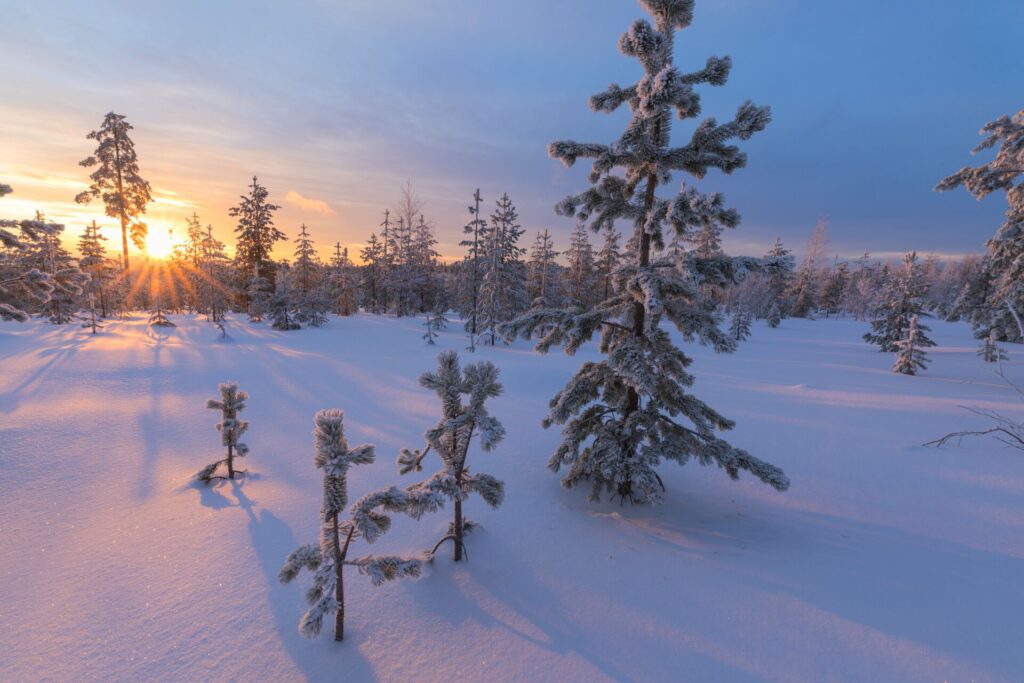

Finland’s seasons at a glance
Each of Finland’s seasons has its own rhythm, weather and daylight extremes. Winter is long, cold and snowbound – especially in Lapland – while spring’s thaw brings brighter days and greening forests. Summer offers long, mild days and near-constant sunlight in the north, followed by autumn’s colourful transformations and the swift cooling that signals the return of the dark months.
While more extreme temperatures occur in Arctic and inland areas, here’s the overall national averages according to the Finnish Meteorological Institute:
Month | Jan | Feb | Mar | Apr | May | Jun | Jul | Aug | Sep | Oct | Nov | Dec |
Avg High (°C) | -6.0 | -6.5 | -2.5 | 3.9 | 11.1 | 17.2 | 20.2 | 18.2 | 11.9 | 5.4 | 0.1 | -3.6 |
Avg Low (°C) | -13.3 | -13.7 | -9.4 | -2.9 | 3.2 | 9.2 | 12.1 | 10.4 | 5.2 | 0.3 | -3.9 | -9.0 |
Winter (December to February)
Winter’s average daytime temperatures range from -14°C in the north to -2°C in the south, with snow depths often exceeding 60cm in the northern forests and reaching 40cm further south. Daylight is minimal – just 2 to 4 hours above the Arctic Circle, and about 6 in Helsinki – with the sun entirely absent in parts of the far-north for several weeks.
Spring (March to May)
Spring arrives unevenly around the country. March can still see highs of -5°C in Lapland and 3°C in the south, but by May, Helsinki often reaches 17°C while Lapland thaws into the low teens. Snow begins to melt in April, retreating from the south and central regions by May, though ski resorts in Lapland might still be open. Daylight starts to increase too, ranging from 10 to 18 hours by late May.
Summer (June to August)
Summer brings warmth and extended daylight – especially above the Arctic Circle, where the midnight sun can shine for weeks. Average highs range from 20°C to 25°C in the south, and 15°C to 20°C in Lapland, though occasional heatwaves can push temperatures past 30°C. Rain averages 50-90mm per month and often comes in short, heavy showers. Nights are light and bright across the country, and Lapland sees no true darkness for much of June and July.
Autumn (September to November)
Conditions change quickly in autumn. September still sees daytime highs of 10°C -15°C, but by November, temperatures fall to around -5°C in Lapland and near 0°C in the south. Rainfall tends to peak in October (up to 80mm), and the first snow typically falls in the north before reaching the south in November. Daylight shortens dramatically, too – from around 13 hours in September to 5 by late November in Helsinki, with even less further north.
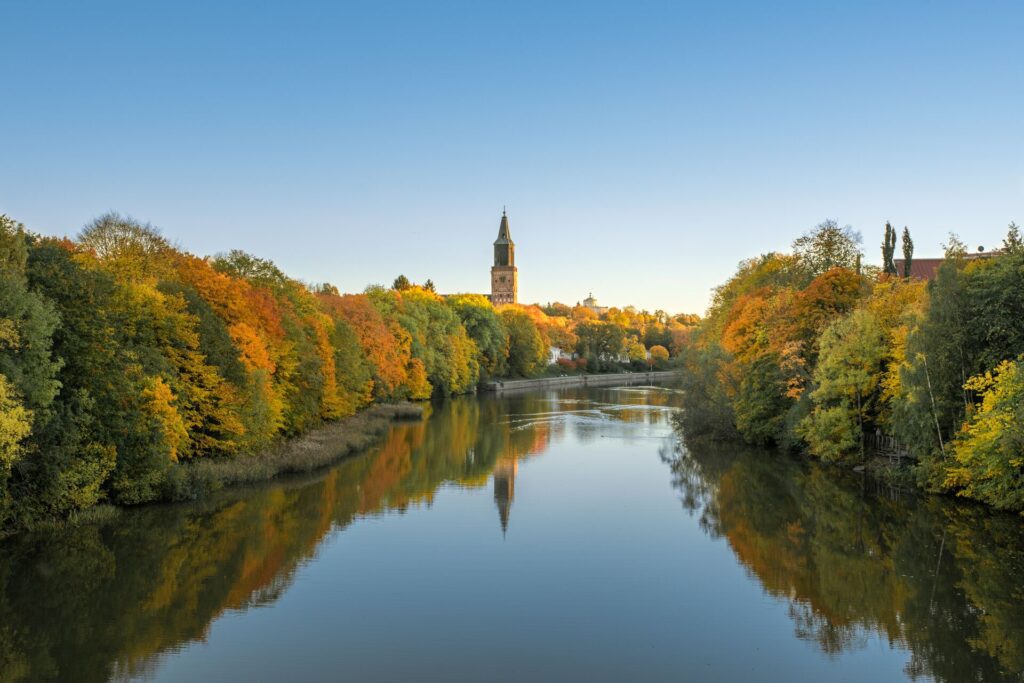

Month-by-Month Guide to Visiting Finland
January in Finland – Arctic Adventures and Deep Winter
A time for deep snow, frozen lakes and long, polar nights. In Helsinki, locals embrace the chill with outdoor swimming, steamy winter saunas and snowy strolls through parks like Kaivopuisto. Further north, Lapland comes alive with snowmobiling and aurora-hunting safaris in Pyhä-Luosto National Park and near Rovaniemi, and you can lean into the full winter experience with an ice hotel stay.
February in Finland – Skiing and Snowy Landscapes
Deep winter rolls on. In Helsinki, you can cross-country ski through Paloheinä and Keskuspuisto, or head 30km northeast to Talma Ski, the closest downhill resort to the city. Snowshoeing routes crisscross national parks across Finland, while Lapland’s ski resorts like Levi, Ruka and Pyhä offer alpine runs, Nordic trails and high-speed husky safaris.
March in Finland – Spring’s Northern Lights
March’s clearer skies are ideal for northern lights adventures. In Lapland, glass-roofed cabins at Levin Iglut and Northern Lights Villages in Saariselkä and Pyhä let you watch the aurora from bed, while electric fat-bike safaris, Sámi-guided experiences and photography tours offer immersive ways to witness Lady Aurora’s spectacular show. While the northern lights are rarely visible in Helsinki itself, your best chance nearby is in Nuuksio National Park – just 45 minutes away – when conditions are right. Learn more about those conditions in our comprehensive guide, The Best Places and Times to See the Northern Lights.
April in Finland – Longer Days, Melting Snow
April brings longer days and thawing trails across Finland. In Helsinki, highs reach 5-10°C and Sipoonkorpi National Park’s paths begin to reopen, while Repovesi offers muddy but rewarding hikes further inland. Lapland stays snowy, with spring skiing in Saariselkä and Pyhä-Luosto still offered. Bird migrations begin across the country too, with Liminka Bay drawing crowds for its cranes, swans and geese, easily viewed from observation towers and wetland boardwalks.
May in Finland – Vappu and Spring Celebrations
This is a month of light and renewal, beginning with Vappu on 1 May – one of the country’s biggest festivals. Originally for workers and students, it now blends parades, outdoor parties and picnics: in Helsinki, crowds fill Kaivopuisto Park in student caps, with similar celebrations in Tampere, Turku and Oulu. Trails reopen in Nuuksio, Koli and Seitseminen national parks, while ferries resume to the Archipelago Sea, a 40,000-island maze stretching from Turku to Åland. In Lapland, snow lingers on the fells but forests begin to green.
June in Finland – Summer Solstice and Light Nights
June in Finland is bright and lively, crowned by the summer solstice (Juhannus) around 21 June. It’s the year’s longest day – Helsinki sees 19 hours of sun, while Lapland stays bright for 24 hours. Around Helsinki, catch the midsummer spirit on Seurasaari Island, where traditional Juhannus festivities include folk dancing and ceremonial bonfires. Coastal towns like Hanko and Rauma are ideal for beach walks and cycling, while inland, Lake Saimaa is perfect for paddling. In Lapland, hike the Karhunkierros Trail or trek from Hetta to Pallas beneath a sun that never sets.
Explore the highlights of Finland, Norway, Denmark and Sweden on our epic 22-day Grand Nordics summer adventure.
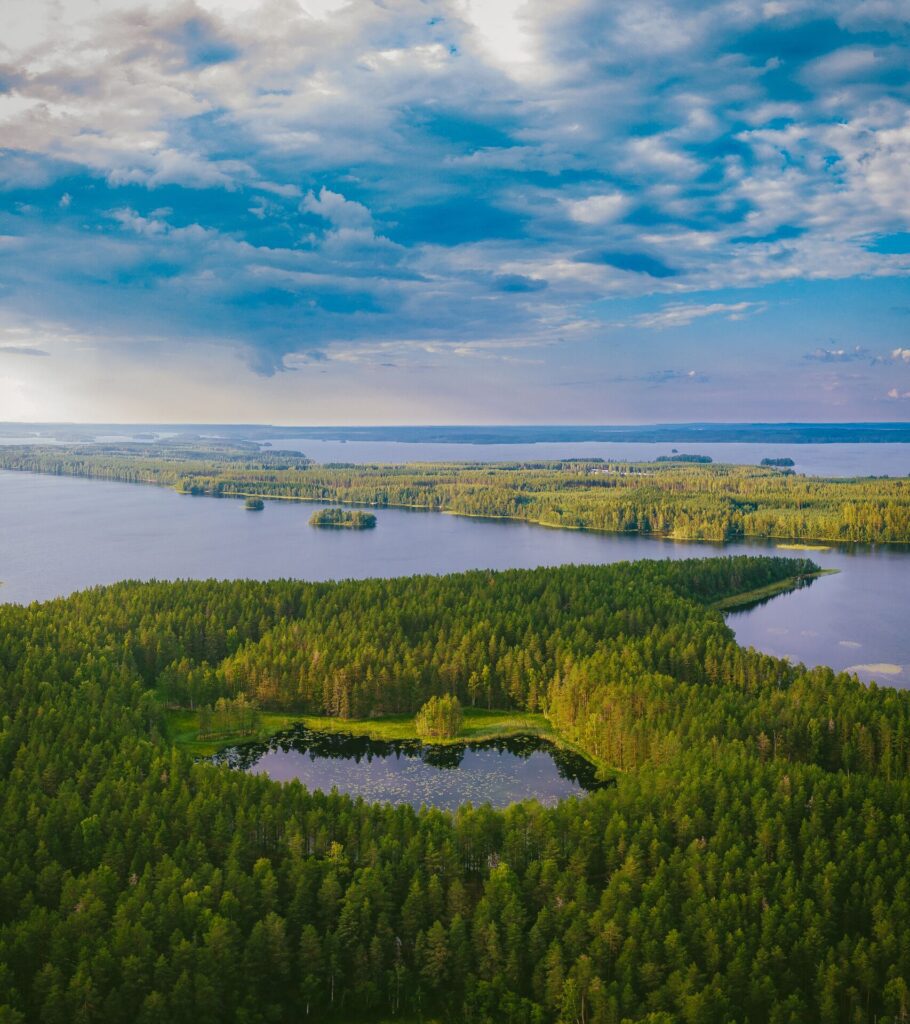

July in Finland – Festivals and Outdoor Fun
Summer’s in full swing. In Helsinki, swimmers crowd the shoreline, ferries link city islands, and Market Square and Esplanadi host seasonal markets. The Lakeland region is alive with activity, with Lake Saimaa, Pielinen and Päijänne offering prime conditions for kayaking, sailing and lakeside saunas, along with wildlife cruises to spot the endangered freshwater Saimaa ringed seal. Repovesi and Leivonmäki’s hiking trails are at their best, while further north, Urho Kekkonen and Pallas-Yllästunturi national parks offer multiday treks through remote Arctic terrain. And festival season peaks with Tangomarkkinat and the Savonlinna Opera Festival.
August in Finland – Quiet at summer’s end
August’s days stay warm – especially in the south – but nights grow cooler and darker, with early signs of autumn in the air. Schools resume mid-month, holidays end, and the country quietens. In Lapland, twilight returns and the trails in Patvinsuo, Salamajärvi and Syöte national parks are quieter, ideal for hiking and wildlife watching.
September in Finland – Autumn Colours and Auroras
September brings crisp air, golden light and a nationwide obsession with ruska – the turning of the leaves – with the earliest displays in Lapland. In the south, forests near Koli, Hämeenlinna and even Helsinki offer gentler ruska walks. As skies darken, the aurora borealis reappears, especially around Ylläs, Nellim and Pyhä-Luosto by mid-month.
October in Finland – Peak Aurora and Crisp Weather
As daylight slips below 10 hours across the country, October’s longer nights bring peak aurora season, particularly in Luosto, Inari, Nellim and Kilpisjärvi, where clear skies and low humidity add to the experience. In Lapland, temperatures drop below freezing and light snow often arrives by mid-month, dusting the fells and creating early opportunities for snowshoeing and short dogsled excursions in some northern resorts. Further south, Helsinki stays milder, with crisp days, windy afternoons and quiet forest walks in Nuuksio and Sipoonkorpi.
November in Finland – Quiet Low Season
November is quiet as the cold sets in. In Lapland, snow deepens and ski resorts open their trails, while Rovaniemi’s Santa Claus Village begins its festive-season activities by mid-month. Daylight dwindles to just a few hours, and while skies are often cloudy, the aurora may still appear on clear nights. Further south, Helsinki’s Senate Square prepares for its Christmas market, and it’s also a great time to escape to the lakes, where Porvoo, Tampere and Lahti offer relaxed sauna stays.
December in Finland – Santa, Polar Nights, and Christmas Magic
Christmas festivities peak around the country. In Lapland, Rovaniemi lives up to its billing as St Nick’s official hometown – home to the Santa Claus Village, the Elf Academy, reindeer sleigh rides and indoor forest dining. From Helsinki, the overnight Santa Claus Express journeys to the Arctic Circle, swapping Senate Square’s glowing Christmas Market for Lapland’s dark, polar nights. In Turku, the historic Christmas Market fills the Old Great Square with craft stalls and carollers, while Tampere’s Central Square becomes a German-style wonderland of lights and festive treats.
Our extraordinary Christmas in Lapland itinerary departs on 23 December 2025 for the ultimate stay in Santa’s hometown.
When to See the Northern Lights in Finland
The northern lights may be seen from late August to early April, with October to March offering your best chances. October stands out for its long, dark nights and generally clear skies, especially across northern Lapland. Cloudier conditions make November less reliable, but sightings significantly improve by late winter. March often brings crisp air and improved visibility, making it another excellent month for aurora chasing. Generally, the further north you go, the better your chances – although even Nuuksio National Park, just 45 minutes from Helsinki, may occasionally offer sightings between October and February.
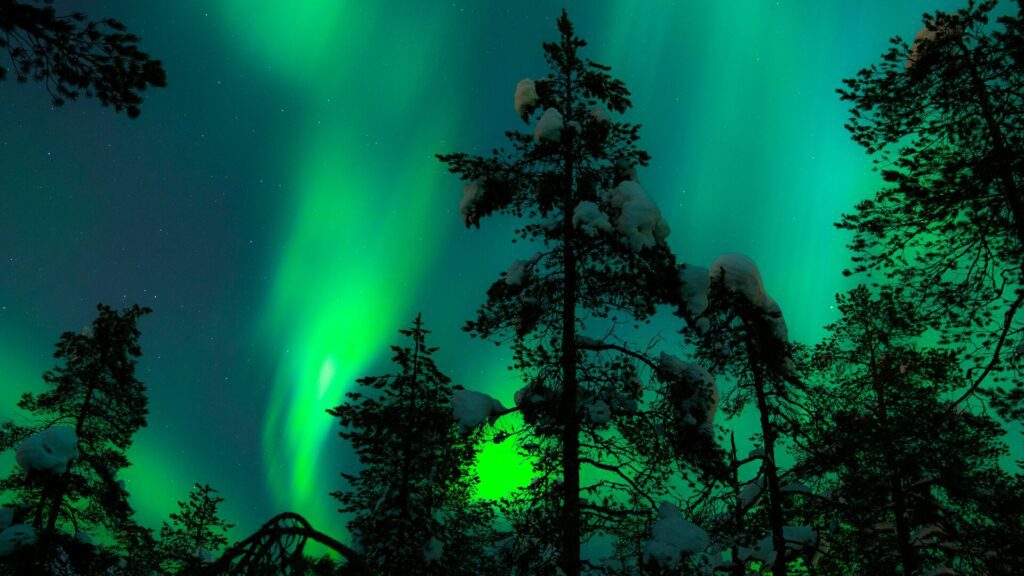

Best Times for Festivals and Events
Skabmagovat Film Festival (January)
Experience the world’s northernmost Indigenous film festival at Skábmagovat, returning to Inari, Finnish Lapland, from 22-25 January 2026. Held during the polar night, this intimate event showcases Sámi and other Indigenous cinema at venues like the Sámi Cultural Centre Sajos, and a unique open-air Snow Theatre.
Vappu (30 April)
Held on 30 April and 1 May each year, Vappu is one of Finland’s liveliest festivals, blending student tradition with spring celebrations. In Helsinki, the party begins with the capping of the Havis Amanda statue, followed by parades, brass bands and crowds in student overalls. On 1 May, tens of thousands gather for picnics and concerts in Kaivopuisto Park and beyond.
Summer Solstice (June)
Juhannus, Finland’s beloved Midsummer festival, will be celebrated on 20-21 June 2025 to mark the summer solstice. In Helsinki, head to Seurasaari Island for folk dancing and a beachside bonfire under the midnight sun. Further inland, Tampere’s Viikinsaari offers live music and family-friendly activities, while up north, organised festivities unfold across Lapland in places like Rovaniemi, Inari and Sodankylä.
Tangomarkkinat (July)
Tangomarkkinat returns to Seinäjoki from 9-13 July 2025, turning this western Finnish city into the beating heart of tango. Throughout the festival, streets pulse with dance-offs and open-air concerts, while headline acts bring the rhythm to the Tango Arena and a new Tango King and Queen are crowned.
Savonlinna Opera Festival (July-August)
Returning from 4 July to 2 August 2025, Savonlinna transforms its 15th century Olavinlinna Castle into one of Europe’s most enchanting stages for shows like Macbeth, Turandot and The Fairy Queen. And don’t miss the Timo Mustakallio Singing Competition, which spotlights rising vocal talent.
Helsinki Baltic Herring Market (October)
The festival runs from 5-11 October 2025 and is a bustling celebration of coastal life and Finnish food. Sample spiced herring straight from docked fishing boats, experience live cooking demos and workshops, and taste your way through stalls stacked with rye bread, pickled vegetables and cloudberry and lingonberry jams.
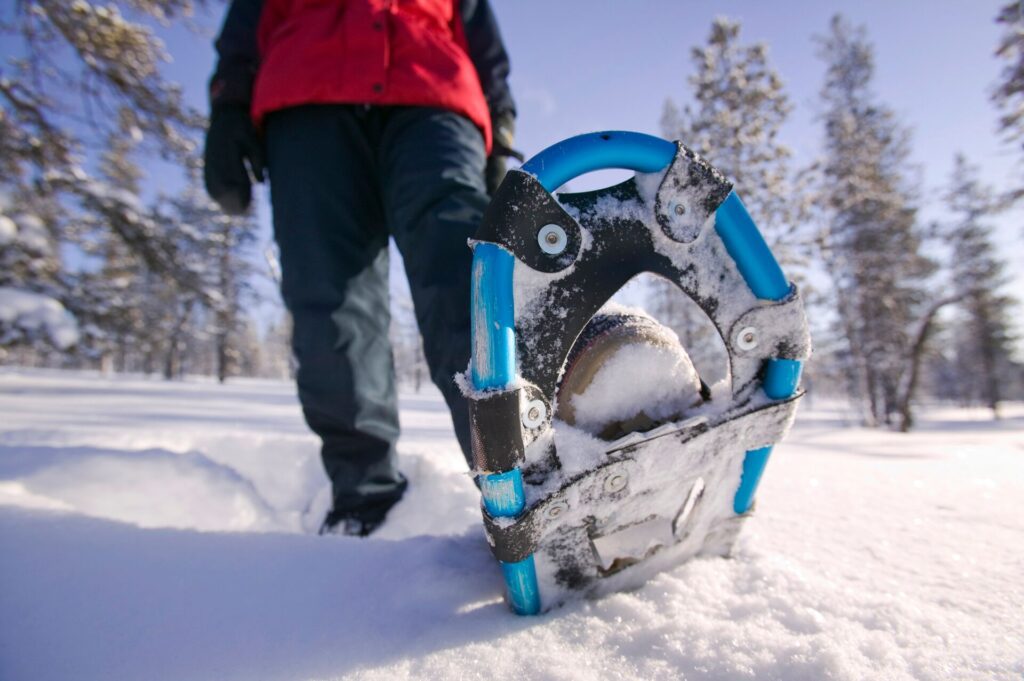

Best Time for Outdoor Activities
Winter Sports
From December to March, Lapland becomes the country’s main winter sports hub. In Levi, Saariselkä and Rovaniemi, you can dogsled through forests, snowmobile over frozen lakes, and ski downhill or cross-country. For gentler adventures, try snowshoeing in Urho Kekkonen National Park or ice fishing. Elsewhere, Nuuksio National Park offers peaceful snowshoe trails and ice-skating close to Helsinki, while Vihti and Talma provide easy-access ski slopes. Not sure what gear to bring on your winter adventure? Our guide, What to Pack for Lapland, has got you covered.
Summer Hiking and Biking
From late May to early September, Finland’s long days and mild weather create ideal conditions for bushwalking and cycling. In the lakes district, the 140km Puumala Archipelago cycling route from Savonlinna journeys between islands by bridge and ferry past pine forests and peaceful villages. For mountain biking, Syöte National Park near Oulu offers 150km of dedicated trails through old-growth forest. Further north, hike into the vast, open landscapes of Urho Kekkonen National Park, where reindeer trails cross Arctic rivers and wilderness huts offer a charming place to sleep beneath the midnight sun. Around Helsinki, there’s coastal hiking and forest biking at Nuuksio and Sipoonkorpi national parks, as well as seafront trails and urban routes.
Spring Forest Bathing and Wildlife
Between April and early June, Finland’s forests defrost and blossom, making this a prime time for forest bathing (metsäkylpy) and spotting wildlife. Near Helsinki, Nuuksio’s trails weave through spruce and birch where elk, foxes and red squirrels are often active at dawn. Liesjärvi National Park, 90 minutes away, has tranquil lakes, mossy boardwalks and few visitors. Near Kuhmo in eastern Finland, guided excursions to forest hides give you the rare chance to observe brown bears, wolverines and grey wolves, especially from mid-May. In the northeast, Oulanka National Park shelters reindeer, otters and the occasional lynx.
Autumn Leaf Viewing
Each September, all across Finland, the forests transform into a kaleidoscope of colour, setting the scene for the much-loved local tradition of ruska viewing. In Salamajärvi National Park, central Finland’s patchwork of forest trails glows gold, and offers the chance to spot rare forest reindeer. In the east, Patvinsuo’s raised boardwalks offer sweeping views over wetlands lit up with scarlet aspen. And in the heart of Helsinki, Kaivopuisto and Seurasaari are spectacular locations to take it all in.
Northern lights photography, snowmobile adventures and aurora cabins are just a few highlights of our customisable Best of Lapland tour.
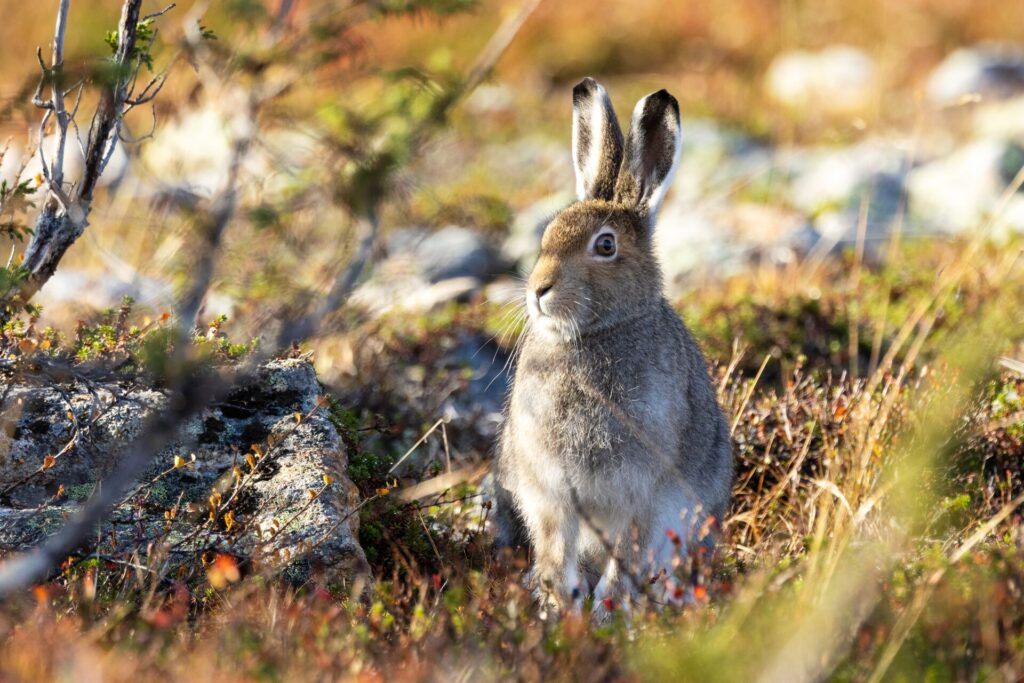

When to Visit Helsinki
This cosmopolitan capital is a year-round highlight, with each season offering its own atmosphere and attractions. In summer, daylight lingers late and the city shifts outdoors – the beachside saunas and outdoor pools are packed, ferries head to Suomenlinna and Pihlajasaari, and concerts and festivals bring the community together. Autumn is quieter – ideal for exploring the Ateneum, Amos Rex and the Helsinki Art Museum, or browsing the Design District and Old Market Hall. In winter, Lux Helsinki, the Senate Square Christmas Market and skating in Esplanadi Park add thrills to the chill, while spring brings longer, brighter days, blooming gardens, and Vappu celebrations. With so much to see and do all year round, Helsinki’s a city for all seasons – and well worth at least a few days’ stay.
Up for a summer adventure? Our Essence of the Nordics journey takes in Helsinki and Lapland, then continues through Norway.
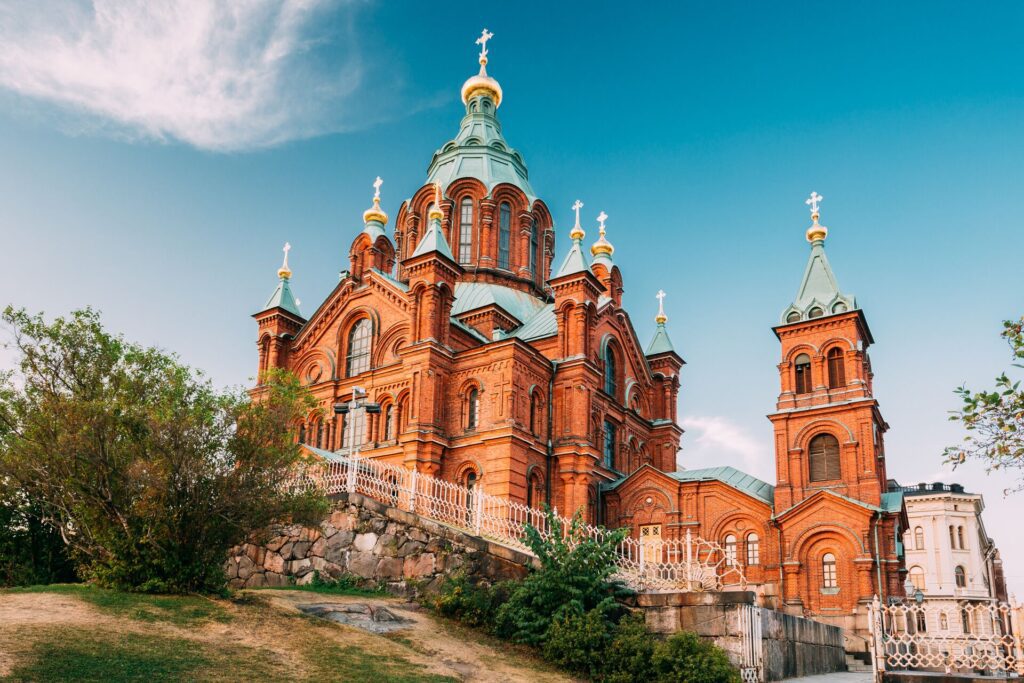

Final Thoughts: Choosing the Right Time to Visit Finland
All in all, the best time to visit Finland depends on whether you want a winter wonderland or summer sunshine. For snow, northern lights and Arctic experiences, head north between October and March. Prefer golden evenings, festivals, lake swims and long hikes? June to August delivers long, light-filled days. Or time your trip for autumn or spring, when the landscapes transform and the crowds thin out. Even better? Plan to come more than once – because Finland reveals something unique and unforgettable every time you visit.
